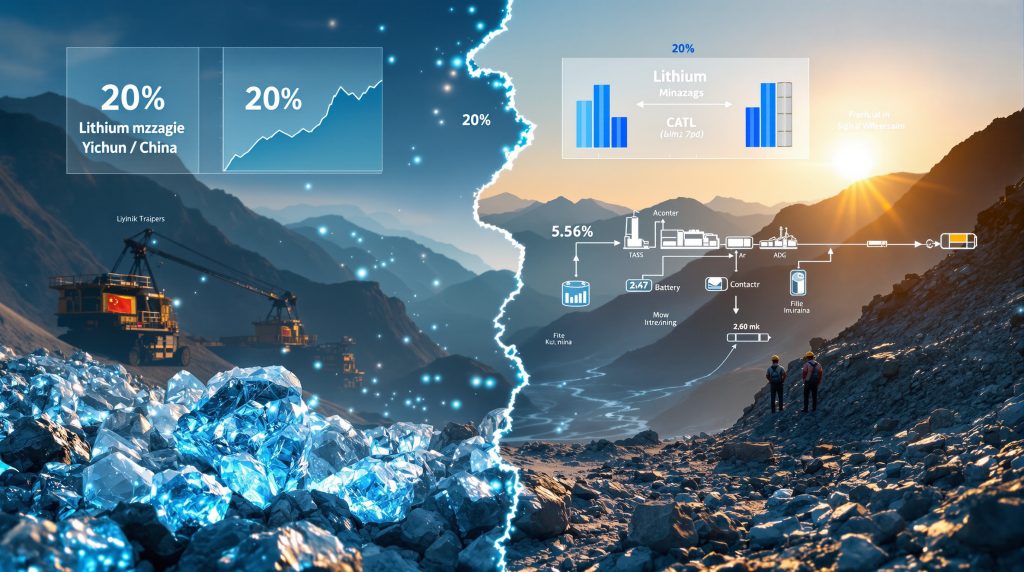Understanding the Yichun Mine Suspension
What Happened at CATL's Lithium Mine?
Contemporary Amperex Technology Co. Limited (CATL), China's battery manufacturing giant, suspended operations at its Jianxiawo lithium mine in Yichun, Jiangxi province on August 9, 2025. The shutdown occurred after the company's mining license expired, forcing an immediate halt to extraction activities at this significant lithium production site.
The suspension wasn't planned as part of regular maintenance but came as a regulatory necessity when CATL failed to secure timely renewal of its operational permits. This highlights the complex regulatory environment in which critical mineral producers operate in China, where compliance requirements can cause significant disruptions to global supply chains.
Chinese authorities have been implementing stricter oversight of mining operations nationwide, with particular focus on strategic minerals like lithium that are essential to the country's electric vehicle ambitions. Understanding mining permit guide requirements has become increasingly crucial for companies operating in this sector.
Why Is the Yichun Mine Strategically Important?
The Jianxiawo mine represents a critical component in China's lithium supply chain, contributing approximately 3% to global lithium production capacity. For CATL specifically, the mine serves as a cornerstone of its vertical integration strategy, providing essential raw materials for its battery manufacturing operations that supply global electric vehicle manufacturers.
Beyond raw production numbers, the Yichun operation is significant because of its high-grade lithium deposits, which yield exceptional quality lithium with lower processing requirements compared to many global competitors. Industry analysts note that the mine's lepidolite deposits contain lithium concentrations averaging 0.8-1.2%, making it one of the more economically viable lithium sources in China's domestic portfolio.
The strategic value of the mine extends beyond CATL's own supply chain. As China positions itself as the global leader in electric vehicle production, maintaining control over key mineral resources provides significant geopolitical leverage in an increasingly resource-competitive global landscape. Recent Australian lithium innovations have also transformed how countries view their lithium resources as strategic assets.
Market Impact of the Production Halt
How Did Lithium Prices React to the Suspension?
Following the announcement of the Yichun mine closure, lithium futures prices experienced a dramatic surge, with lithium carbonate prices jumping over 20% in Chinese markets. This price volatility highlighted the mine's significance to global supply chains and demonstrated the market's sensitivity to disruptions in critical mineral production.
The immediate market reaction was most pronounced on the Shanghai Metals Market, where spot prices for battery-grade lithium carbonate increased from approximately 98,000 yuan ($13,500) per tonne to nearly 120,000 yuan ($16,600) per tonne within three trading sessions. This sharp increase reflected both actual supply concerns and speculative trading activity.
Market analysts observed that the price response was disproportionate to the actual supply disruption, indicating the psychological impact of uncertainty around critical mineral availability. This psychological factor reveals how lithium markets are still maturing, with price discovery mechanisms that can overreact to short-term production challenges.
International markets showed a more measured response, with prices on the London Metal Exchange rising approximately 8-10% during the same period, suggesting greater buffer capacity in global supply chains outside of China's domestic market. Many investors are keeping a close eye on Argentina lithium market insights for alternative supply options.
Which Companies Benefited from the Suspension?
The temporary shutdown created a notable ripple effect across lithium markets:
| Company Type | Market Response |
|---|---|
| Lithium Miners | Share prices surged as supply constraints raised profit expectations |
| Alternative Suppliers | Competitors like Yongxing Special Materials saw increased demand |
| Battery Manufacturers | Faced potential input cost increases and supply chain adjustments |
Among the most significant beneficiaries was Yongxing Special Materials, which secured a new mining license in the Yichun area during the period of CATL's suspension. This timely approval allowed Yongxing to capitalize on the supply gap, with their stock price appreciating approximately 15% in the weeks following the announcement.
Other Chinese lithium producers including Ganfeng Lithium and Tianqi Lithium saw their share prices rise 8-12% as markets anticipated higher profit margins from elevated lithium prices. International producers like Albemarle and SQM experienced more modest gains of 3-5%, reflecting the primarily regional nature of the supply disruption.
For battery manufacturers and automakers, the situation presented supply chain challenges that required rapid adaptation. Companies with diversified lithium sourcing strategies proved more resilient, while those heavily dependent on Chinese domestic supply faced greater uncertainty and potential cost increases.
Resumption Timeline and Expectations
When Will Production Resume at the Yichun Mine?
According to reports from China's Securities Times, CATL is expected to resume operations at the Jianxiawo lithium mine soon, following approximately one month of suspension. The company has been actively engaged in negotiations with regulatory authorities to expedite the renewal process.
Industry sources familiar with Chinese mining regulations suggest that standard license renewal procedures typically require two to three months, making this expedited timeline notable. The accelerated process likely reflects both CATL's strategic importance to China's industrial policy and the economic impact of the production halt.
Technical preparations for restart have been underway throughout the suspension period, with maintenance crews maintaining equipment readiness to minimize the transition time once regulatory approval is secured. This preparatory work includes safety inspections, equipment calibration, and workforce scheduling to ensure a smooth production ramp-up.
The mine's expected restart timeline aligns with China's broader policy objectives of maintaining stable supply chains for its dominant electric vehicle manufacturing sector, which represents a strategic national priority in the country's industrial development plans.
What Factors Are Influencing the Permit Renewal Process?
Several key elements are affecting the timeline for resumption:
-
Regulatory Scrutiny: China's increased oversight of mining operations has introduced more comprehensive compliance reviews before license renewals are granted. This includes assessments of environmental management systems, safety protocols, and resource utilization efficiency.
-
Environmental Compliance: Stricter standards for extraction activities now require mining operations to demonstrate improved water management, reduced emissions, and comprehensive reclamation planning. Sources within the industry indicate that CATL has invested significantly in environmental technologies at the Yichun site to meet these elevated standards.
-
Capacity Control Measures: Government efforts to manage lithium production growth reflect Beijing's strategic approach to resource management. Authorities are balancing the need for adequate supply with concerns about oversupply driving down prices and threatening the economic viability of domestic producers.
-
Administrative Procedures: Bureaucratic processes for permit renewal involve multiple agencies including the Ministry of Natural Resources, environmental protection authorities, and local government officials. This multi-stakeholder approval process introduces complexity that can extend timelines even for priority projects.
Technical experts note that the Chinese government has recently implemented a more sophisticated regulatory framework that considers not just compliance factors but also strategic supply chain considerations in the permit renewal process. This approach reflects the maturation of China's mineral resource governance as the country balances immediate industrial needs with longer-term resource conservation goals.
Broader Context of China's Lithium Industry
How Does This Fit Into China's Resource Strategy?
The temporary suspension at Yichun aligns with Beijing's broader approach to managing its critical mineral resources. China has been implementing policies to:
-
Control excessive capacity in the EV battery sector through strategic production quotas and licensing requirements
-
Ensure sustainable development of lithium resources by implementing more rigorous extraction standards and requiring improved recovery rates
-
Maintain strategic leverage in global supply chains by balancing domestic production with overseas investments and acquisitions
-
Balance environmental concerns with production needs through enhanced regulatory oversight and technological upgrading requirements
China's approach reflects a sophisticated understanding of lithium's strategic importance beyond immediate market considerations. The country's planners recognize that control over lithium resources provides significant geopolitical leverage in an era of accelerating global energy transition.
Recent policy documents from China's National Development and Reform Commission emphasize the concept of "resource security" as a key component of national security, placing lithium among a select group of minerals deemed essential to the country's industrial autonomy and technological leadership.
What Other Developments Are Affecting China's Lithium Sector?
The Yichun situation occurs against a backdrop of significant changes in China's lithium landscape:
-
New mining licenses being granted to companies like Yongxing Special Materials represent a careful expansion of production capacity to meet growing domestic demand while avoiding market oversupply
-
Consolidation among smaller producers has accelerated as authorities favor larger, more technologically advanced operations that can implement best practices in extraction and processing
-
Increased focus on recycling and alternative technologies, with major investments in lithium recovery from spent batteries and development of sodium-ion alternatives for certain applications
-
Growing competition from international lithium sources, particularly in Australia, Chile, and Argentina, challenging China's dominant position in the processing segment of the supply chain
Geological experts note that China's domestic lithium resources, while significant, face challenges including lower average grades and more complex mineralogy compared to some international deposits. This geological reality has shaped the country's dual strategy of developing domestic resources while securing overseas supply through strategic investments and long-term agreements.
Supply Chain Implications
How Might the Resumption Affect Global Lithium Markets?
The anticipated restart of operations at the Yichun mine is expected to stabilize lithium prices that had surged following the suspension. Market analysts anticipate:
-
Gradual normalization of spot prices as supply concerns ease, with potential reversion to pre-suspension levels within 4-6 weeks of resumed production
-
Reduced pressure on battery manufacturers' input costs, supporting continued cost reduction trajectories for electric vehicle batteries
-
Restored confidence in supply chain reliability, potentially reducing the risk premium currently embedded in lithium futures contracts
-
Potential moderation of speculative trading activity as market fundamentals reassert themselves over short-term disruption concerns
Trading patterns on the Shanghai Metals Market suggest that sophisticated investors are already positioning for price stabilization, with futures contracts showing decreased volatility as information about the expected resumption has circulated through industry channels.
For international markets, the Yichun resumption represents one factor in an increasingly complex global lithium landscape, where production expansions in Australia and South America are counterbalanced by accelerating demand growth from battery manufacturing facilities worldwide. India's recent development of a battery-grade lithium refinery illustrates the global race to develop processing capacity.
What Does This Reveal About Supply Chain Vulnerabilities?
The Yichun situation highlights several critical vulnerabilities in global lithium supply chains:
-
Concentration risk from geographic clustering of production, with significant portions of global supply dependent on regulatory decisions in a small number of jurisdictions
-
Regulatory dependencies affecting operational continuity, where administrative processes can cause material disruptions to global supply
-
Limited buffer capacity to absorb production disruptions, with inventory levels throughout the supply chain often maintained at minimal levels to reduce carrying costs
-
Market sensitivity to even temporary production halts, revealing the immaturity of price discovery mechanisms in critical mineral markets
Supply chain experts note that the Yichun case demonstrates how regulatory factors can now rival technical or geological factors as potential disruption sources in critical mineral markets. This represents an evolution in risk profiles that requires more sophisticated supply chain management strategies from downstream users.
The rapid price response to both the suspension and anticipated resumption also highlights how information flows through lithium markets, with significant price movements often preceding official announcements as industry participants respond to early signals and informal communications.
Future Outlook for CATL and Lithium Production
What Are CATL's Long-term Plans for Lithium Security?
Following this disruption, CATL is likely to implement several strategic adjustments:
-
Diversifying supply sources beyond the Yichun operation to reduce concentration risk, potentially through additional domestic acquisitions or international partnerships
-
Establishing more robust permit renewal processes with dedicated regulatory affairs specialists to anticipate compliance requirements and prevent future lapses
-
Potentially acquiring additional mining assets to ensure supply security, with particular focus on deposits with favorable geological characteristics and stable regulatory environments
-
Strengthening relationships with regulatory authorities through enhanced compliance programs and alignment with national industrial policy objectives
Industry analysts suggest that CATL's experience will accelerate its vertical integration strategy, with increased emphasis on securing raw material supplies through ownership rather than contractual arrangements. This shift reflects growing recognition of supply security as a competitive advantage in the rapidly evolving battery manufacturing landscape.
Technical innovations in CATL's resource development approach may also emerge from this experience, with increased investment in extraction efficiency, mineral processing technologies, and resource recovery techniques to maximize the value derived from existing assets. These changes are part of broader mining industry evolution trends reshaping resource extraction globally.
How Might This Incident Influence Global Lithium Development?
The temporary suspension at Yichun could accelerate several industry trends:
-
Increased investment in lithium projects outside China, as battery manufacturers and automakers seek to diversify geographic risk in their supply chains
-
Greater emphasis on supply chain resilience among battery makers, potentially leading to higher inventory levels and more redundant sourcing strategies
-
More attention to regulatory compliance and permit management, with companies developing specialized expertise in navigating the increasingly complex regulatory landscapes around critical minerals
-
Acceleration of exploration activities in emerging lithium regions, including frontier areas in Africa, Europe, and North America, as the strategic value of diverse supply sources becomes more apparent
The incident may also influence how lithium assets are valued in corporate transactions, with increased premium placed on operations in jurisdictions with transparent, predictable regulatory frameworks and established permitting processes.
For policymakers globally, the Yichun case provides a clear demonstration of how regulatory decisions impact critical mineral markets, potentially informing more coordinated approaches to resource governance that balance legitimate oversight needs with supply chain stability considerations.
FAQ: CATL's Yichun Lithium Mine
What percentage of global lithium supply comes from the Yichun mine?
The Jianxiawo lithium mine in Yichun contributes approximately 3% to global lithium production capacity, making it a significant single source in the worldwide supply chain. While this may seem modest, the mine's impact is magnified by its role in China's domestic supply network and its high-grade ore quality, which yields battery-grade lithium with relatively efficient processing requirements.
Why did lithium prices increase after the mine suspension?
Prices surged because markets anticipated a supply shortage from the sudden removal of a major production source, triggering both actual supply constraints and speculative trading. The price reaction was amplified by limited inventory buffers throughout the supply chain and psychological factors as traders responded to uncertainty about resumption timelines and regulatory implications for other Chinese lithium operations.
Who granted the new mining license in the Yichun region?
Authorities granted a new mining license to Yongxing Special Materials, another company operating in the Yichun lithium hub, helping to partially offset regional production losses. This approval came through China's Ministry of Natural Resources, working in coordination with provincial authorities in Jiangxi. The timing of this approval suggests a coordinated regulatory approach to maintaining regional production levels while individual permit issues are resolved.
What regulatory changes might follow this incident?
Potential regulatory responses could include more structured permit renewal timelines, clearer compliance guidelines, and possibly a more transparent process for mining license administration. Industry observers suggest that Chinese authorities may implement enhanced monitoring systems for permit expiration dates and create more standardized renewal procedures to prevent similar disruptions at other strategic mineral operations.
How does this affect electric vehicle manufacturers?
While the short-term disruption created uncertainty, the expected quick resumption means EV manufacturers will likely avoid significant production challenges or cost increases that would have resulted from a prolonged shutdown. Companies with diverse sourcing strategies were better positioned to weather the temporary disruption, highlighting the importance of supply chain resilience in the rapidly evolving electric vehicle ecosystem.
Conclusion: Lessons from the Yichun Mine Suspension
The temporary halt at CATL's Yichun lithium mine offers valuable insights into the evolving dynamics of critical mineral supply chains. As production resumes, market conditions should stabilize, but the incident serves as a reminder of the delicate balance between regulatory oversight and production continuity in strategic resource sectors.
The experience highlights the importance of proactive permit management, diversified supply sources, and collaborative relationships between industry and regulatory authorities. For global markets, it underscores how even temporary disruptions at single production sites can trigger significant price volatility in critical minerals essential to the energy transition.
This case study demonstrates the growing importance of non-geological factors in mineral supply security, with regulatory frameworks, administrative processes, and compliance capabilities increasingly determining production outcomes alongside traditional considerations like resource quality and extraction costs.
As the energy transition accelerates global demand for lithium and other battery minerals, both producers and consumers will need to develop more sophisticated approaches to managing supply chain risks, including regulatory factors that can impact production continuity in key mining regions.
Ready to Stay Ahead of Major Mineral Discoveries?
Discovery Alert's proprietary Discovery IQ model delivers real-time notifications on significant ASX mineral discoveries, instantly empowering you to identify actionable opportunities before the broader market. Begin your 30-day free trial today at Discovery Alert and secure your market-leading advantage.




